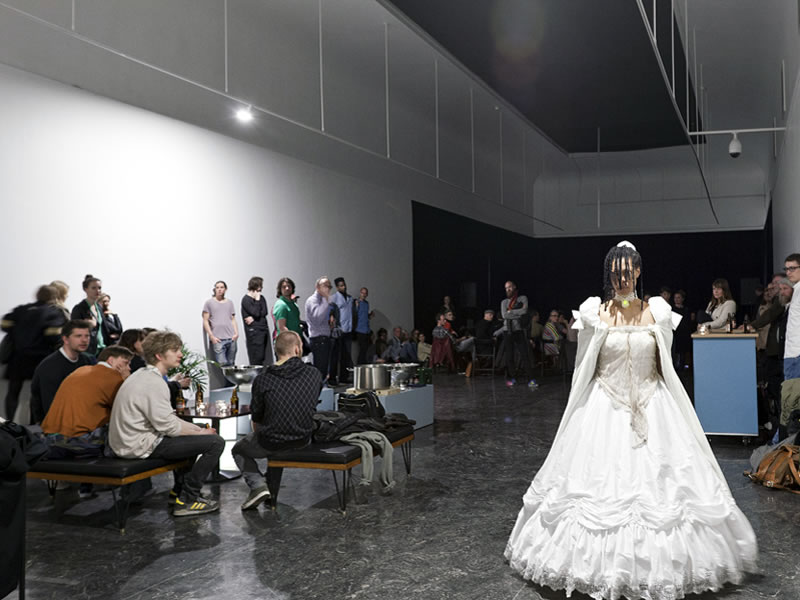selected work
sonic/performance
From the Apparition Series
Performance Art
6 May 2013 One Night Only, Kunstnerneshus, Oslo



In a “still-life” performance, Camille Norment places herself in the time of the origin of the rare musical instrument, the glass armonica. She appears as the apparition, a paradoxical character that plays upon cultural dissonance, and intertwines the past with the present; a subject always already appeared and already disappeared.
The glass armonica was invented in 1761 by Benjamin Franklin during the ‘Age of Enlightenment’. It was an era that praised itself for its scientific, cultural, and social achievements, contemplated “the rights of man” and yet, women were still not considered as equals by law, and slavery was justified as a qualifiable economic means.
Made of pure crystal, and played with water, the glass armonica produces a sound that likens itself to a digital sine wave, the foundation for contemporary electronic music. It was an instrument thought to have powerful effects on the body and the mind and was even used by Franz Mesmer (from whom the term mesmerize is derived) to hypnotize. The glass armonica was thought to be the voice of angels by many, and was soon to be feared and outlawed in the belief that its sound was too powerful or even sinister, a force. The instrument disappeared from practice for nearly 200 years.
Avant guard musician Sun Ra is celebrated as a visionary who sought to re-write the historical place given to him as a black American by playing himself into the future through his philosophy and experimental music. He turned, what musicologists would call ‘the worried note’ of the black American music tradition, into futuristic tones of empowerment. In this performance, Camille Norment accompanies a digital manipulation of Sun Ra’s “Angels and Demons”. The piece drags through time like the lingering notes of a forgotten song in time with the re-shaping of land by water.
With the premier performance, Camille wishes to acknowledge the centennial commemoration of the women’s right to vote in Norway, the 100th year since the birth of Sun Ra, and the continued strides towards equal human rights world wide.



In a “still-life” performance, Camille Norment places herself in the time of the origin of the rare musical instrument, the glass armonica. She appears as the apparition, a paradoxical character that plays upon cultural dissonance, and intertwines the past with the present; a subject always already appeared and already disappeared.
The glass armonica was invented in 1761 by Benjamin Franklin during the ‘Age of Enlightenment’. It was an era that praised itself for its scientific, cultural, and social achievements, contemplated “the rights of man” and yet, women were still not considered as equals by law, and slavery was justified as a qualifiable economic means.
Made of pure crystal, and played with water, the glass armonica produces a sound that likens itself to a digital sine wave, the foundation for contemporary electronic music. It was an instrument thought to have powerful effects on the body and the mind and was even used by Franz Mesmer (from whom the term mesmerize is derived) to hypnotize. The glass armonica was thought to be the voice of angels by many, and was soon to be feared and outlawed in the belief that its sound was too powerful or even sinister, a force. The instrument disappeared from practice for nearly 200 years.
Avant guard musician Sun Ra is celebrated as a visionary who sought to re-write the historical place given to him as a black American by playing himself into the future through his philosophy and experimental music. He turned, what musicologists would call ‘the worried note’ of the black American music tradition, into futuristic tones of empowerment. In this performance, Camille Norment accompanies a digital manipulation of Sun Ra’s “Angels and Demons”. The piece drags through time like the lingering notes of a forgotten song in time with the re-shaping of land by water.
With the premier performance, Camille wishes to acknowledge the centennial commemoration of the women’s right to vote in Norway, the 100th year since the birth of Sun Ra, and the continued strides towards equal human rights world wide.
